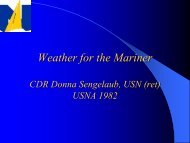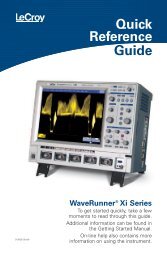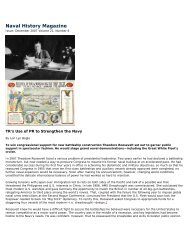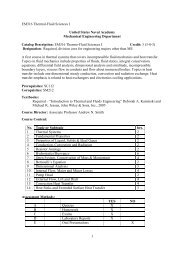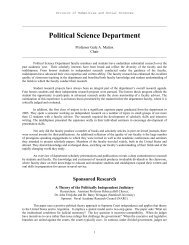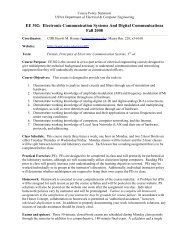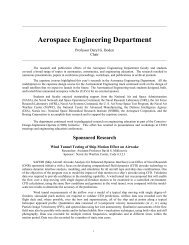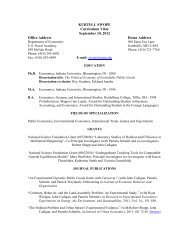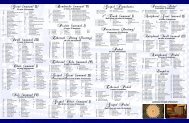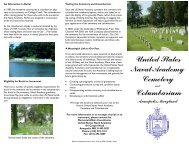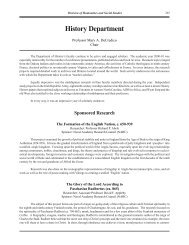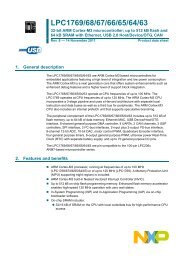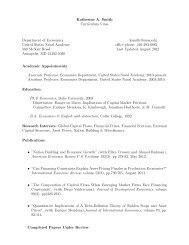Computer Science Department - United States Naval Academy
Computer Science Department - United States Naval Academy
Computer Science Department - United States Naval Academy
- No tags were found...
You also want an ePaper? Increase the reach of your titles
YUMPU automatically turns print PDFs into web optimized ePapers that Google loves.
<strong>Computer</strong> <strong>Science</strong> <strong>Department</strong>161Md5deepResearcher: Captain Jesse Kornblum, USAFThis research continued the development of md5deep, a cross-platform set of programs that computes MD5message digests or SHA-1 message digests on an arbitrary number of files. The programs run on Windows, Linux,FreeBSD, OS X, Solaris, and should run on most other platforms. Md5deep is similar to the md5sum program found in theGNU Coreutils package, but it has several additional features.Midshipman Research Course ProjectsEvolutionary Software Development and Simulationfor an Urban Search and Rescue RobotResearcher: Midshipman 1/C Jeffrey Pinney, USNAdviser: Assistant Professor Frederick L. Crabbe, IVThe goal of this project was to use genetic algorithms (GA) to develop controls for an already existing robot. Thesecontrols are complex and perform certain functions that accomplish pre-defined search and rescue obstacles. Genetic algorithmswere needed because the complexity was too great to accomplish the controls kinematically. <strong>Computer</strong> simulationwas used in conjunction with the GA for testing. The simulation for testing was completed, and the groundwork for the GAwas put in place. In the future, the GA will be used to develop a controller that effectively controls the robot to perform allthe tasks necessary to be an urban search and rescue robot.Collaborative Networked Environments for Military TrainingResearcher: Midshipman 1/C Keith G. Labbe, USNAdviser: Major Mark J. Lennerton, USMCSponsor: Bowman Scholar ProgramThe research undertaken in this proposal was a joint venture with the <strong>Naval</strong> Postgraduate School (NPS). Oncea secure Virtual Private Network (VPN) connection was established and tested locally, a connection with NPS wasestablished. This connectivity provided and served as a test bed in determining VPN functionality in meeting the needs forcontinued collaborative Virtual Environment (VE) and information technology (IT) research. A commercial off the shelf(COTS) desktop VE was initially used to test issues such as bandwidth requirements/availability, latency, and barriers tocollaborative communication and coordination. Once established, customized and scaled, bicoastal collaborative sessionswere connected to explore performance in pursuit of collaborative goals. Additional collaborative sessions were conductedthroughout to gain a better understanding of the human factors involved in using VEs.High Energy Laser Modeling and Simulation Framework EvaluationResearcher: Midshipman 1/C Erik C. Eckstrand, USNAdviser: Associate Professor Donald M. NeedhamSponsor: Bowman Scholar ProgramThis research centered on the modification of an existing software architecture framework that provided thecommunication backbone between high energy laser propagation models. IT evaluated whether one component of an endto-endsoftware simulation framework, such as a laser’s wave front propagation component, could be modified or replacedto allow for the inclusion of emerging lasing codes, and assessed the impact of such changes on the rest of the simulationframework. This project contributed to the High Energy Laser Joint Technology Office’s efforts by incorporating an existinglaser propagation model into the Northrop Grumman High Energy Laser Simulation (HELSEEM) framework, and examinedthe feasibility of incorporating legacy laser propagation codes into the HELSEEM framework. The specific incorporationprocess was detailed, with particular attention given to problems likely to be encountered by developers of subsequent laserpropagation codes. Lessons learned from the incorporation process, as well as recommendations for the improvement ofthe process, were identified and discussed.



